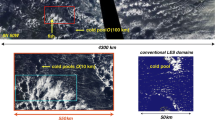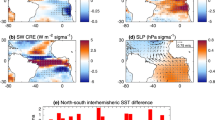Abstract
Simulations of subtropical marine low clouds and their radiative properties by nine coupled ocean-atmosphere climate models participating in the fourth assesment report (AR4) of the intergovernmental panel on climate change (IPCC) are analyzed. Satellite observations of cloudiness and radiative fluxes at the top of the atmosphere (TOA) are utilized for comparison. The analysis is confined to the marine subtropics in an attempt to isolate low cloudiness from tropical convective systems. All analyzed models have a negative bias in the low cloud fraction (model mean bias of −15%). On the other hand, the models show an excess of cloud radiative cooling in the region (model mean excess of 13 W m−2). The latter bias is shown to mainly originate from too much shortwave reflection by the models clouds rather than biases in the clear-sky fluxes. These results confirm earlier studies, thus no major progress in simulating the marine subtropical clouds is noted. As a consequence of the combination of these two biases, this study suggests that all investigated models are likely to overestimate the radiative response to changes in low level subtropical cloudiness.






Similar content being viewed by others
References
Allan RP, Ringer MA (2003) Inconsistencies between satellite estimates of longwave cloud forcing and dynamical fields from reanalyses. Geophys Res Lett 30(9):1491. doi:10.1029/2003GL017019
Bony S, Dufresne J-L (2005) Marine boundary layer clouds at the heart of tropical cloud feedback uncertainties in climate models. Geophys Res Lett 32(L20):806. doi:10.1029/2005GL023851
Bony S, Dufresne J-L, Le Treut H, Morcrette J-J, Senior C (2004) On dynamic and thermodynamic components of cloud changes. Clim Dyn 22:71–86
Cess RD, Potter GL, Blanchet JP, Boer GJ, Del Genio AD, Déqué M, Dymnikov V, Galin V, Gates WL, Ghan SJ, Kiehl JT, Lacis AA, Le Treut H, McAvaney BJ, Meleshko VP, Mitchell JFB, Morcrette J-J, Randall DA, Rikus L, Roeckner E, Royer JF, Schlese U, Sheinin DA, Slingo A, Sokolov AP, Taylor KE, Washington WM, Wetherald RT, Yagai I (1990) Intercomparison and interpretation of climate feedback processes in 19 atmospheric general circulation models. J Geophys Res 95(D10):16601–16615
Cess RD, Zhang MH, Ingram WJ, Potter GL, Alekseev V, Barker HW, Cohen-Solal E, Colman RA, Dazlich DA, Del Genio AD, Dix MR, Esch M, Fowler LD, Fraser JR, Galin V, Gates WL, Hack JJ, Kiehl JT, Le Treut H, Lo KK-W, McAvaney BJ, Meleshko VP, Morcrette J-J, Randall DA, Roeckner E, Royer J-F, Schlesinger ME, Sporyshev PV, Timbal B, Volodin EM, Taylor KE, Wang W, Wetherald RT (1996) Cloud feedback in atmospheric general circulation models: an update. J Geophys Res 101(D8):12791–12794
Charlock TP, Ramanathan V (1985) The albedo field and cloud radiative forcing produced by a general circulation model with internally generated cloud optics. J Atmos Sci 42:1408–1429
Coakley JAJ, Baldwin DG (1984) Towards the objective analysis of clouds from satellite imagery data. J Clim Appl Meteor 23:1065–1099
Collins W, Rasch P, Boville B, Hack J, McCaa J, Williamson D, Kiehl J, Briegleb B, Bitz C, Lin S, Zhang M, Dai Y (2004) Description of the NCAR community atmosphere model (CAM 3.0), tech note TN-464+STR. Technical report. National Center For Atmospheric Research, Boulder
Delworth TL, Broccoli AJ, Rosati A, Stouffer RJ, Balaji V, Beesley JA, Cooke WF, Dixon KW, Dunne J, Dunne KA, Durachta JW, Findell KL, Ginoux P, Gnanadesikan A, Gordon CT, Griffies SM, Gudgel R, Harrison MJ, Held IM, Hemler RS, Horowitz LW, Klein SA, Knutson TR, Kushner PJ, Langenhorst AR, Lee H-C, Lin S-J, Lu J, Malyshev SL, Milly PCD, Ramaswamy V, Russell J, Schwarzkopf MD, Shevliakova E, Sirutis JJ, Spelman MJ, Stern WF, Winton M, Wittenberg AT, Wyman B, Zeng F Zhang R (2006) GFDL’s CM2 global coupled climate models. Part I: formulation and simulation characteristics. J Clim 19:643–674
Gnanadesikan A, Dixon KW, Griffies SM, V Balaji, Barreiro M, Beesley JA, Cooke WF, Delworth TL, Gerdes R, Harrison MJ, Held IM, Hurlin WJ, Lee H-C, Liang Z, Nong G, Pacanowski RC, Rosati A, Russell J, Samuels BL, Song Q, Spelman MJ, Stouffer RJ, Sweeney CO, Vecchi G, Winton M, Wittenberg AT, Zeng F, Zhang R, Dunne JP (2006) GFDL’s CM2 global coupled climate models. Part II: the baseline ocean simulation. J Clim 19:675–697
Harrison EF, Minnis P, Barkstrom BR, Ramanathan V, Cess RD, Gibson GG (1990) Seasonal variation of cloud radiative forcing derived from the earth radiation budget experiment. J Geophys Res 95:18687–18703
Hartmann D, Ockert-Bell M, Michelsen M (1992) The effect of cloud type on earth’s energy balance: global analysis. J Clim 5:1281–1304
IPCC, Solomon S, Qin D, Manning M, Chen Z, Marquis M, Averyt K, Tignor M, H M (eds) (2007) IPCC: climate change 2007: the scientific basis. Contribution of working group I to the fourth assessment report of the intergovernmental panel on climate change. Technical report. Cambridge University Press, Cambridge, p 996
Jakob C, Tselioudis G (2003) Objective identification of cloud regimes in the tropical western pacific. Geophys Res Lett 30(21):2082. doi:10.1029/2003GL018367
K-1 Model Developers (2004) K-1 coupled model (MIROC) description. Hasumi H, Emori S (eds) Tech. report 1. Technical report, Center for Climate System Research. University of Tokyo, Tokyo
Klein S, Hartmann DL (1993) The seasonal cycle of low stratiform clouds. J Clim 6:1587–1606
Klein S, Jakob C (1999) Validation and sensitivities of frontal clouds simulated by the ECMWF model. Mon Weather Rev 127:2514–2531
Li Z, Trishchenko A (2001) Quantifying uncertainties in determining sw cloud radiative forcing and cloud absorption due to variability in atmospheric conditions. J Atmos Sci 58:376–389
Marti O, Bellier J, Benshila R, Bony S, Brockmann P, Cadulle P, Caubel A, Denvil S, Dufresne J, Fairhead L, Filiberti M-A, Fichefet T, Friedlingstein P, Grandpeix J-Y, Hourdin F, Krinner G, Lévy C, Musat I, Talandier C (2005) The new IPSL climate system model: IPSL-CM4. Report 26. Technical report, Institut Pierre Simon Laplace, Paris
Pope V, Gallani M, Rowntree P, Stratton R (2000) The impact of new physical parametrizations in the Hadley Centre climate model-HadAM3. Clim Dyn 16:123–146
Potter GL, Cess RD (2004) Testing the impact of clouds on the radiation budgets of 19 AMIP models. J Geophys Res 109(D2):106. doi:10.1029/2003JD004018
Ramanathan V, Cess RD, Harrison EF, Minnis P, Barkstrom BR, Ahmad E, Hartmann D (1989) Cloud-radiative forcing and climate: results from the earth radiation budget experiment. Science 243:57–63
Ringer M, Allan R (2004) Evaluating climate model simulations of tropical cloud. TELLUS A 56:308–327
Rossow W, Schiffer R (1999) Advances in Understanding Clouds from ISCCP. Bull Am Meteor Soc 80:2261–2287
Siebesma AP, Bretherton CS, Brown A, Chlond A, Cuxart J, Duynkerke PG, Jiang H, Khairoutdinov M, Lewellen D, Moeng C-H, Sanchez E, Stevens B, Stevens DE (2003) A large eddy simulation intercomparison study of shallow cumulus convection. J Atmos Sci 60:1201–1219
Slingo J (1980) A cloud parametrization scheme derived from gate data for use with a numerical model. Quart J Roy Meteor Soc 106:747–770
Slingo A (1990) Sensitivity of the Earth’s radiation budget to changes in low clouds. Nature 343:49–51
Soden BJ, Held IM (2006) An assessment of climate feedbacks in coupled ocean-atmosphere models. J Clim 19:3354–3360
Stephens G (2005) Cloud feedbacks in the climate system: a critical review. J Clim 18:237–273
Svensson G, Tjernström M, Koracin D (2000) The sensitivity of a stratocumulus transition: model simulations of the astex first lagrangian. Bound Layer Meteor 95:57–90
Washington W, Weatherly J, Meehl G, Semtner A Jr, Bettge T, Craig A, Strand W Jr, Arblaster J, Wayland V, James R, Zhang Y (2000) Parallel climate model (PCM) control and transient simulations. Clim Dyn 16:755–774
Weare BC (1999) Combined satellite- and surface-based observations of clouds. J Clim 12:897–913
Weare BC (2004) A comparison of AMIP II model cloud layer properties with ISCCP D2 estimates. Clim Dyn 22:281–292
Weare BC, Mokhov II, Amip Modeling Groups (1996) Evaluation of the vertical structure of zonally averaged cloudiness and Its variability in the atmospheric model intercomparison project. J Clim 9:3419–3431
Webb M, Senior C, Bony S, Morcrette J (2001) Combining ERBE and ISCCP data to assess clouds in the Hadley Centre, ECMWF and LMD atmospheric climate models. Clim Dyn 17:905–922
Webb MJ, Senior CA, Sexton DMH, Ingram WJ, Williams KD, Ringer MA, McAvaney BJ, Colman R, Soden BJ, Gudgel R, Knutson T, Emori S, Ogura T, Tsushima Y, Andronova N, Li B, Musat I, Bony S, Taylor KE (2006) On the contribution of local feedback mechanisms to the range of climate sensitivity in two GCM ensembles. Clim Dyn 27:17–38
Wei Y, Doutriaux M, Séze G, Le Treut H, Desbois M (1996) A methodology study of the validation of clouds in GCMs using ISCCP satellite observations. Clim Dyn 12:389–401
Williams KD, Tselioudis G (2007) Gcm intercomparison of global cloud regimes: present-day evaluation and climate change response. Clim Dyn 29:231–250. doi:10.1007/s00382-007-0232-2
Williams KD, Senior CA, Mitchell JFB (2001) Transient climate change in the Hadley centre models: the role of physical processes. J Clim 14:2659–2674
Williams K, Senior C, Slingo A, Mitchell J (2005) Towards evaluating cloud response to climate change using clustering technique identification of cloud regimes. Clim Dyn 24:701–719. doi:10.1007/s00382-004-0512-z
Wyant M, Bretherton C, Bacmeister J, Kiehl J, Held I, Zhao M, Klein S, Soden B (2006) A comparison of low-latitude cloud properties and their response to climate change in three agcms sorted into regimes using mid-tropospheric vertical. Clim Dyn 27:261–279. doi:10.1007/s00382-006-0138-4
Yu Y, Zhang X, Guo Y (2004) Global coupled ocean-atmosphere general circulation models in LASG/IAP. Adv Atmos Sci 21:444–445
Zhang MH, Lin WY, Klein SA, Bacmeister JT, Bony S, Cederwall RT, Del Genio AD, Hack JJ, Loeb NG, Lohmann U, Minnis P, Musat I, Pincus R, Stier P, Suarez MJ, Webb MJ, Wu JB, Xie SC, Yao M-S, Zhang JH (2005) Comparing clouds and their seasonal variations in 10 atmospheric general circulation models with satellite measurements. J Geophys Res 110(D15):S02. doi:10.1029/2004JD005021
Acknowledgments
Thanks go to Frida Bender for good discussions and critical comments. The ERBE-data were obtained from the NASA Langley Research Center Atmospheric Sciences Data Center. The climatological monthly mean ISCCP D2 data were obtained from the International Satellite Cloud Climatology Project web site http://isccp.giss.nasa.gov maintained by the ISCCP research group at the NASA Goddard Institute for Space Studies, New York, NY on March, 2005. ICOADS data provided by the NOAA-CIRES Climate Diagnostics Center, Boulder, Colorado, USA, from their Web site at http://www.cdc.noaa.gov/. We acknowledge the international modeling groups for providing their data for analysis, the Program for Climate Model Diagnosis and Intercomparison (PCMDI) for collecting and archiving the model data, the JSC/CLIVAR Working Group on Coupled Modelling (WGCM) and their Coupled Model Intercomparison Project (CMIP) and Climate Simulation Panel for organizing the model data analysis activity, and the IPCC WG1 TSU for technical support. The IPCC Data Archive at Lawrence Livermore National Laboratory is supported by the Office of Science, U.S. Department of Energy.
Author information
Authors and Affiliations
Corresponding author
Rights and permissions
About this article
Cite this article
Karlsson, J., Svensson, G. & Rodhe, H. Cloud radiative forcing of subtropical low level clouds in global models. Clim Dyn 30, 779–788 (2008). https://doi.org/10.1007/s00382-007-0322-1
Received:
Accepted:
Published:
Issue Date:
DOI: https://doi.org/10.1007/s00382-007-0322-1




